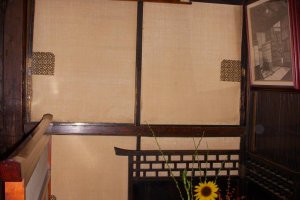During the Edo era, there were two main routes from Kyoto to Edo (Tokyo). The lower, most widely known route, was the Tokaido. The other, more interior route, was called the Nakasendo. Preserved along a portion of the Nakasendo are a series of old post towns that keep that old Edo charm focusing on traditional wooden architecture and small shops.
Narai, is one of the premier towns along this route and a great escape for urbanites that really want to slow it down, way down. The town itself, has only one primary lane about 500 meters long with wooden storefronts featuring unique overhanging eaves. Accommodation wise there are only a handful of 旅館 (ryokan) and homestays in Narai, and most visitors are content to take their walkabout through town and journey onward along the Nakasendo to find their lodging. So I was naturally a bit excited when I found out me, my wife, and her parents would be staying at Echigoya, the oldest ryokan in Narai at over 200 years old and nine generations of family owned proprietorship.
An inn as old as Echigoya focuses on simplicity, quietude, and attention to detail. No distractions here. The inn, and all it has to offer are your only entertainment, so it is important to prepare your mind in a zen like manner beforehand. You and your group's comfort are the sole focus at Echigoya, indeed it is the only possible focus, as this small traditional inn has only enough space for a maximum of two families. Our party of four constituted the only reservation for the night, so the family staff was eagerly awaiting our arrival around 3:00 PM.
Upon checking in we were served green tea and then were free to enjoy the sights and sounds of the wooden home. Immediately we were playfully greeted by the hosts toddler daughter as she shyly slid back a paper shoji door instigating an impromptu game of hide and seek. It was a subtle reminder that everyone plays their part in this inn's warm family hospitality. The wooden building is a testament to two centuries of arduous upkeep, and you can feel that craftsmanship with every subtle creek of the floor. After taking a soak in its small cypress wood bath and changing into yukata, our dinner was brought to us and each course was explained in detail. I particularly enjoyed the local koi sashimi with miso paste sauce. Not your standard fish dish, but surprisingly good. We became even more impressed when our host revealed our lacquerware dinner trays are the inn's original set, dating back to the early 19th century, and carefully maintained by a local specialist.
Before, calling it a night we slipped into our personal wooden geta and evening haori (this additional coat is needed for Narai's cool mountain air, even in the summer) for a short stroll down the stone street with an open sky of stars beaming down, our heel clicks echoing through the otherwise silent promenade. Echigoya is such a well known landmark, and securing a reservation so sought after, that other travelers couldn't resist taking photos of us as we gathered in our traditional clothes in front of the entrance. A case of travel-jealously turned paparazzi.
Finally sufficiently exhausted, we each washed up in the open air wash basin beside Echigoya's interior garden. We then retired to our futon prepared rooms and fell asleep to the creeking of the inns wooden joints and babbling of the Naraigawa fifty meters away. Being that our room was on the second floor, the steep design of the antique wooden staircase made for a harrowing, but enjoyable, midnight bathroom runs.
The morning breakfast was light but meticulously prepared, just as dinner the night before. Unfortunately we are out the door for our train by 8 AM, as trains aren't so frequent, and one day in Narai is usually all that is required to soak in it's traditional charm. Plus, with a one night stay costing around 15,000 yen a night/per person, one can see why. Also, Echigoya allows guests to only stay one consecutive night, ensuring that as many groups as possible have the opportunity to experience its beauty throughout the year.
Spending that next whole day on train rides and exploring other post towns en route to Nagoya, we are happy to finally get on the Shinkansen to head back to Tokyo, and what seems like a bizarro world after only a day and a half in “old Japan”.
































